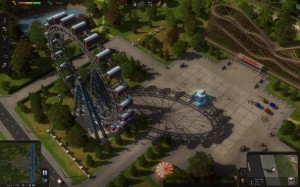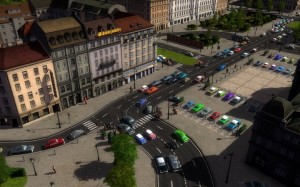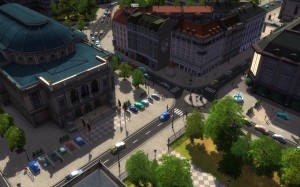We recently published a preview on Cities in Motion, a mass-transport simulation game not unlike Transport Tycoon. Since we’ve received quite a bit of interest in this title, we took the opportunity to speak to Mariina Hallikainen, CEO of Colossal Order, to find out more about Cities in Motion and the game studio that develops it!
For readers who are unaware, could you tell us a little about Colossal Order? Who are you and what other games have you developed in the past?
 Colossal Order was found in 2009 by a small but very enthusiastic and experienced group of people. Antti Isosomppi, Antti Lehto and Mikko Tyni are the people behind the original concept and starting the company. Though earlier they worked in the mobile game industry, PC strategy games have always been their passion. They have been active game developers in the demo scene for years and as serious fans of the genre they could finally develop the game they’ve always wanted to. Cities in Motion is the company’s first title and truly a passionate project for the start-up company that employs now ten talented people.
Colossal Order was found in 2009 by a small but very enthusiastic and experienced group of people. Antti Isosomppi, Antti Lehto and Mikko Tyni are the people behind the original concept and starting the company. Though earlier they worked in the mobile game industry, PC strategy games have always been their passion. They have been active game developers in the demo scene for years and as serious fans of the genre they could finally develop the game they’ve always wanted to. Cities in Motion is the company’s first title and truly a passionate project for the start-up company that employs now ten talented people.
The immediate comparison most people will make when watching the trailer, or looking at the various screen shots is with Transport Tycoon. There hasn’t been a good game in this genre for a while now – what are your thoughts about this?
People behind Cities in Motion are true fans of the great classic games like Transport Tycoon. The lack of good games in the genre in the recent years was noticed by us and that is something we thought about when starting the development of Cities in Motion. We hope to bring back the essence of fun known in these games and also have gorgeous graphics and highly detailed simulation of the living world.
The information released so far describes 5 different modes of transportation. Could you elaborate on these? We’ve seen a wide range of vehicles in the information that has been released so far.
The player builds his transport network and can operate with buses, trams, subway trains, helicopters and water buses. There’s a nice selection of over 30 different vehicles to choose from. Each of these player vehicles are based on a real life models and are carefully selected into the game to represent the time and technology of a certain time period. Other vehicles in the game are not operated by the player but are in the role of transporting more passengers to the player’s network, like long distance trains and airplanes.
You’ve described a real-time city and traffic simulator. Does this mean we can expect a citizen to travel from their home to their job by any means necessary or does each person have specific needs and requirements?
 The citizens have certain needs; they are working, shopping and spending time in various locations around the city. By default all of the citizens use their own car unless the player’s transport network is better suited for them. So, for example, the player needs to think of the placement of the stops and stations, ticket prices and attractiveness of the transport to meet the citizens’ needs.
The citizens have certain needs; they are working, shopping and spending time in various locations around the city. By default all of the citizens use their own car unless the player’s transport network is better suited for them. So, for example, the player needs to think of the placement of the stops and stations, ticket prices and attractiveness of the transport to meet the citizens’ needs.
If a player does not meet the demands of a particular group of citizens, could this potentially affect the economy of the city? E.g. if there is no train connection between a residential area and an industrial area – would this hurt the industry or would workers find alternative modes of transport?
The citizens will always be able to travel. If the public network is not suited for their needs, they’ll use their own cars. The player needs to build his transport network so that the citizens will want to use it instead of their own cars.
Could you tell us a little more about the 7 different social groups? What kind of groups should we expect?
The social groups have different travelling needs and demands for the transport network. For example, the business people don’t care so much of the ticket prices as to a fast route to their destination, whereas students are much more sensitive to the price of the travel, but they are not too demanding with the condition of the vehicles. There are different groups from tourists to dropouts.
How is construction handled in the game? Is the player free to build anywhere, or do you need to purchase rights first? Can we assume the player is limited to their current budget – with money coming in from the various types of transport?
The player is free to build almost anywhere, though destroying existing buildings can get costly very quickly. The player starts with a budget but he’s able to take loans from banks for bigger investments. The money comes in from sold tickets, penalty fees (there’s always someone trying to travel without a ticket) and completing objectives. The player is also able to sell used equipment, for lower price of course.
Does the game feature any natural disasters or other random events that could really change the course of a game?
 There’s a lot happening in the cities that can disrupt the transport system. Nothing too serious though. We wouldn’t want the player’s hard work to be destroyed in seconds. The effective changes are more subtle and happen in a longer period of time, so the player has time, if he notices them, to react to the changes.
There’s a lot happening in the cities that can disrupt the transport system. Nothing too serious though. We wouldn’t want the player’s hard work to be destroyed in seconds. The effective changes are more subtle and happen in a longer period of time, so the player has time, if he notices them, to react to the changes.
What are the main differences between the four cities, besides for the scenery?
The cities were chosen so that the landscape and the best possible vehicle types would vary as much as possible. Also the amount of citizens and the growth of the city are different in these four cities.
What can a player expect out of the campaign? Is there some sort of story, does the player go through various years of technological advancement or is it a set of objective based scenarios tied together?
There’s a storyline and 12 objective based scenarios in the campaign. The player gets to see the cities in different times and levels of growth and economic situations. In one scenario the player must solve the transport for a huge upcoming event or change the existing network to more environmentally friendly one. Completed objectives unlock the sandbox mode.
Thank you for taking the time to answer our questions about Cities in Motion – and the best of luck during the development of the game! We look forward to its release in early 2011.
Thank you! It was a pleasure to answer your questions.
Best regards on behalf of the whole dev team,
Mariina Hallikainen, CEO
This game is starting to look more and more interesting every time we get more information about it. Highly recommend keeping an eye on this one!